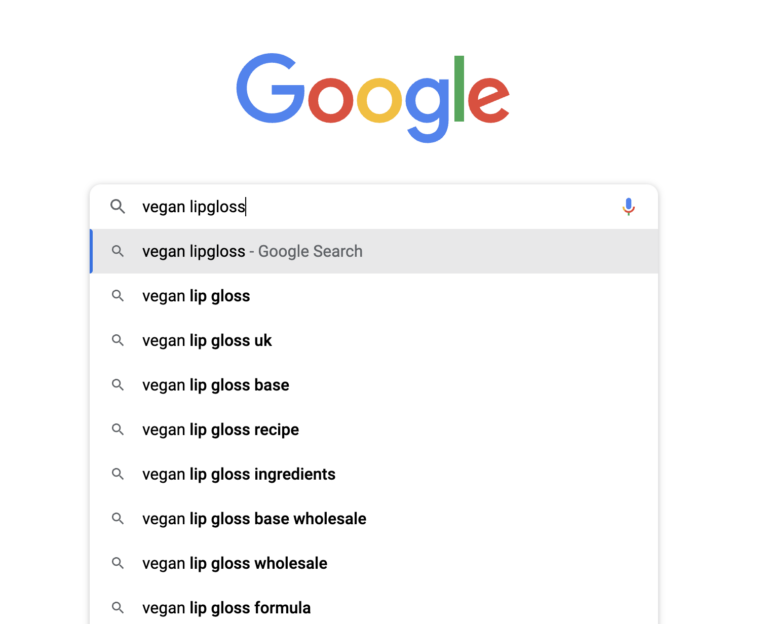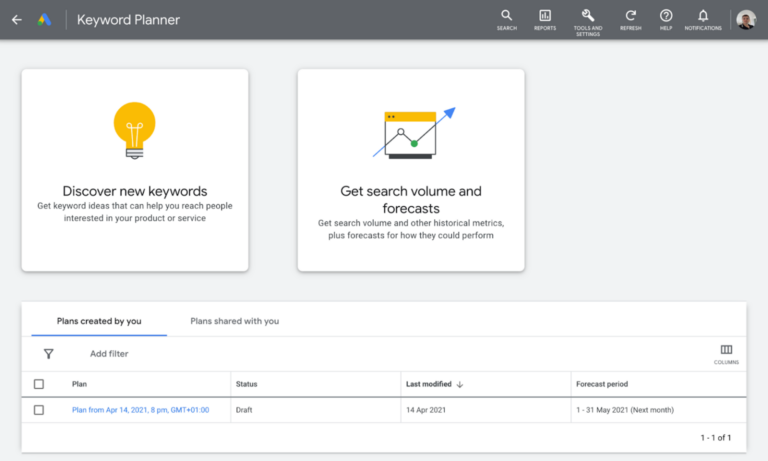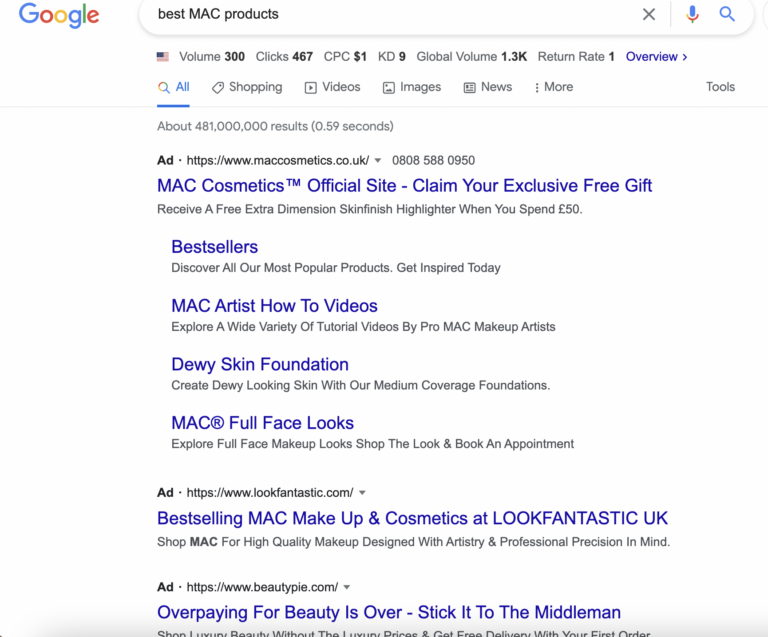Everyone knows that for eCommerce businesses, PPC (pay-per-click) Advertising works. Building a social media presence and a content marketing strategy can of course be effective, but they’re a long play. If you want to start scaling your sales now, paid ads are a powerful shortcut!
PPC campaigns and paid search strategies more broadly are one of the most reliable and scalable models for selling clean, sustainable, or ethical beauty products. Some of our biggest and most successful clients as an agency are online beauty product sellers. PPC ads get you in front of your target audience who are looking for what you offer, at that exact moment. So…how do you start utilizing PPC ads for your beauty/cosmetics brand??
As the title suggests, this article is all about nailing your keyword strategy specifically for ethical, eco-friendly cosmetics brands, and we’ll be talking about keywords specifically for Google Ads (the ‘big dog’ in the paid search world). At Snowball Creations, we do run PPC campaigns across Bing and Facebook, but we’ve found none of them quite have the power of Google!
If you’re still working out your digital marketing plan and feel like it’s too early to start paying for clicks, then you might find our “Pre-launch checklist for paid ads” video helpful to make sure you have everything set up correctly before you take the plunge…
What Are Google Ads Keywords?

There are 3 main keyword types you can choose between, all with different pros and cons to them depending on what you’re trying to achieve.
Google’s Explanation
Keywords are words or phrases that are used to match your ads with the terms that people are searching for.
Selecting high-quality, relevant keywords for your advertising campaign can help you reach the customers that you want, when you want.
Our Thoughts
In short, a keyword is a collection of worlds placed together in a sequence. These words are then used as parameters when search engines like Google are trying to find relevant content for a user’s search on their platform.
In order to make a sequence of words a keyword, you need to place quotation marks around them within your ad account. For example, by searching “cruelty-free lipgloss”, you will be included in the bidding for that specific combination of words, and possibly have your ad show up for anyone searching for that or something similar.
The next step is understanding the difference between each keyword match type. Which keyword type you choose to use will affect what kind of searches your ads will appear under. The main 3 to remember are Broad, Phrase, and exact match.
We like to think of the different match types as fishing nets. Broad match is the widest metaphorical net you can cast across Google search, whereas Exact match is the smallest, most specific net possible. Phrase is somewhere in the middle…
What Is A Broad Match Type Keyword?
Google’s Explanation
A keyword match type allows your ad to show on searches that are related to the meaning of your keyword, which can include searches that don’t contain the keyword terms. This allows you to reach more searches than with exact and phrase matches.
Our Thoughts
As mentioned above, you can think of a broad keyword as the biggest widest net you can cast. Out of all the match-type options available to you, this one will allow Google to take the reign the most and find any search terms that link to your keyword in some way. It isn’t strict.
For example, using the keyword “Cruelty-free lipgloss” as a broad keyword type can allow your ad to show up for searches like “Cruelty-free shampoo”, OR “How to make your own lipgloss”.
Now, it is also possible with a broad keyword to show up for exactly the keyword you selected word-for-word, but the point is you can also appear for the above examples as they all include at least one of the words in your chosen keyword. Essentially, anything at all related can match.
One pro however of using broad keyword match types is the sheer volume of people you can reach. The majority of the time, broad keywords will reach a far larger audience than the other options available.
But it is very important to focus on regularly adding and updating your negative keywords when your campaign is using broad match types. This way you can try to limit the number of unrelated searches that are commonly showing your adverts.
Broad keywords require much more time and energy into regularly adding negative keywords. That’s how you make a broad keyword campaign effective.
If you’re confused about what a negative keyword is, then keep reading…
What Is A Phrase Match Type Keyword?
Google’s Explanation
A keyword match type that allows you to show your ads on searches that include the meaning of your keyword. The meaning of the keyword can be implied, and user searches can be a more specific form of the meaning. This allows you to reach more searches than with exact match and fewer searches than with broad match.
Our Thoughts
Phrase match is the next step down from Broad. It’s less wide reaching, and more precise with what searches your ad will show up for.
Over the last few years, the phrase match type has definitely become less and less precise. Google seems to be moving it closer to a broad match, as they try to boost advertiser spending by increasing the amount of places your ads can show and and the amount of clicks you get.
Overall though, phrase should help you show up for less irrelevant searches, but still keep a high level of search volume. It’s a keyword type we use a lot as an agency.
One thing to keep an eye out when using phrase match keywords is the ‘Close variant’ label in your search terms section of your ad account. This shows you when Google has found a similar search that matched your keyword closely enough. So if you set “Cruelty-free lipgloss” as a phrase match, you could potentially show up for searches such as “Cruelty-free lipstick”. For most, these close variants are still pretty good quality searches to show up for, and have similar search intent to your original keyword.
But as mentioned above, Google is far from perfect and you can still show up for some less relevant searches with this match type. For example, you could also show up for “Cruelty-free nail gloss” which while similar, is a completely different product that you may not sell and your ad and landing page won’t match with.
Negative keyword management is still definitely important when using phrase match though.
What Is An Exact Match Type Keyword?
Google’s Explanation
A keyword match type that allows you to show your ads on searches that have the same meaning or same intent as your keyword. Exact match gives you the most control over who sees your ad, but reaches fewer searches than both broad and phrase match. This allows you to reach only users who make searches with the same meaning as your keywords, including:
Misspellings, Singular or plural forms, Stemmings, Abbreviations, and Accents.
Our Thoughts
Exact match is basically the smallest, and most precise ‘net’ you can use on the platform. It’s because of this that it’s one of our favourites to use.
By using Exact Match Keywords, you’re giving Google the tightest parameters possible for your ads. This means that, most of the time, your ads will only appear under the closest variants to your original keyword and nothing else.
Setting “Sustainable lipgloss” as an exact match could still allow your ads to show up for searches like “Sustainable lipgloss USA” or “Sustainable Lipgloss kit”, but with exact match it’s unlikely you’d show up under searches like “Sustainable skincare” OR “Sustainable mascara”.
By using exact match, you’re also less likely to waste budget on low quality searches. However, one downside is that you may notice the ‘low search volume’ error message popping up more frequently with this match type if you’re selection is too niche or it’s very ‘longtail’.
This isn’t the end of the world though. If you realise there aren’t enough people looking for say “sustainable lipgloss kit UK”, then there just isn’t a large enough audience to spend money advertising on.
PPC Keyword Research For Clean Beauty Brands

Aside from keyword types, obviously the other part of your keyword strategy to work on is deciding on the keywords you want to bid on.
It’s all about tyring to rank for searches with exactly the right intent to buy. But depending on your niche and products, you might need to go further up the sales funnel to a more broadly related term i.e. “sustainable vegan skincare” versus “skincare UK”.
You won’t have to look far online to find countless different digital marketing, and specifically keyword research tools and guides to help you with this stage. But, in our experiecne, the tools Google provides within your account, alongside your own mind are just as effective (and don’t cost anything).
So here are our tips for starting your keyword research. First of all, create a new GoogleDoc or Word doc and begin tpying out any ideas that come to mind. You’re trying to imagine what your target market might be searching for if they were trying to find what you sell. Gather your team and have a brain storming session!!
You might think it should be more complex or complicated, but at the end of the day, you probably use Google daily yourself (along with 4 billion others), so you don’t have to be an expert in advertising to know how your customer base could use it.
You can also just simply use the auto-fill feature in search engines to help inspire ideas.
You can see in the picture below when I typed out “vegan lipgloss” Google then showed me various suggestions for what I could search alongside those words. Some of these suggesitons might be good ideas for your keywords!
On the flip side of that, you can also use this technique to discover common searches that you don’t want to show up for. So in the above scenario, “vegan lipgloss recipe” would not be a good fit for a company trying to sell ready to buy lip products. The search intent is wrong!

You can also use Google Ads’ own ‘keywords planner’. To access this just go to your ad account > Tools & Settings > Planning > Keyword Planner.

We usually recommend sorting your chosen keywords into different ad groups that have the same search intent.
“Sustainable lipgloss” and “sustainable lipkit” for example are similar in that they are both targeting the sustainability angle, so it makes sense to group them in one ad group. Whereas with “vegan lipgloss” the user has a pretty different search intent. They care specifically whether your products are plant-based, so you want to group all vegan keywords together perhaps.
By doing this you’re ensuring that the adverts you create actually make sense and relate to the search your potential customer is doing. If they’re searching vegan lipgloss, they’re more likely to click on an ad with ‘Vegan lipgloss’ as the title over one with “sustainable lipgloss. That’s why we split into separate ad groups.
It can be difficult, especially when starting out, to filter the very best keywords from the batch that will produce the most conversions for you. To start with it’ll just be an (informed) guessing game based on your knowledge of your brand, market, and customers, but over time the data will speak for itself.
The number of keywords you need completely depends on your available ad budget. Usually we’d suggest starting on the tighter side with your targeting and then work backwards from there.
How Much Should Clean Beauty Businesses Spend On PPC?

As a highly competitive and overcrowded marketing, PPC budgets for cosmetics, skincare, and beauty brands can get used up quickly if you’re not smart. If you go to broad with your keywords you might end up spending a ton of money per click and per conversion, making it unprofitable for you depending on your average order value.
The key is making sure your keyword and match types align with your available ad spend.
It can be hard to know what a sufficient budget for your beauty/cosmetics business is without knowing your goals, products, finances etc. However to give you a basic guide, £1000 – £2,000 per month we’d say is a modest budget, and then anything up from there is even more ammunition to use to get to a return on ad spend (ROAS) even quicker.
If you’re using words/phrases frequently searched, or your keywords only have 1-2 words in them, you will likely have a high volume of people seeing your adverts. However is you use longer (longtail) keywords, or focus on a more niche search then you will be put in front of less people generally speaking.
The goal is to be as targeted as possible, whilst still just about hitting your set ad spend limits.
Should You Bid On Beauty eCommerce Competitors?
Competitor ghosting is a widely used PPC strategy in most industries, especially in the eCommerce world if your products have a USP setting them apart from your competitors. Check out this video we made all about how to do Ghosting and if it’s worth it:
If we look at the popular makeup brand ‘MAC’ for example. When you Google their name you also see ads from competitors like Beauty Pie who have positioned an ad as an affordable alternative to MAC:

So yes, competitor ghosting can work for clean beauty products. However, in our experience in this industry, someone searching for a specific makeup brand for example probably already has loyalty to that brand and so ghosting competitors is unlikely to work unless you’re very aggressive with messaging around being cheaper or better in some way.
You do however want to consider that it also can be a more expensive strategy, as your quality scores won’t be as high on those ads chasing competitors. Google can see that you aren’t the brand name you’re bidding on, so your ad will never have as high quality scores as the actual competitor brand, so they will pay far less for a lick. Google understands you aren’t what the customer was initially looking for.
Google may by default label close competitors as ‘close variants’ even outside of this strategy, so there is a chance you’ll show up for searches for competitors without even trying. It’s for this reason, I’d suggest waiting to try ghosting until you’ve seen wether those searches actually convert for you.
Negative Keywords For Clean Beauty Companies

Google’s Explanation
Negative keywords let you exclude search terms from your campaigns and help you focus on only the keywords that matter to your customers. Better targeting can put your ad in front of interested users and increase your return on investment (ROI).
Our Thoughts
The truth is, even if you become a paid ads guru, you’re still going to show up for bad searches no matter how much time you put into your ad copy, content marketing and PPC strategy.
But fear not, there is a well-known way to combat this – Negative keywords!
When you do inevitably show up under some searches that aren’t a good fit or are just downright wastes of money, it’s also pretty likely that most users won’t click your ad anyway as your copy won’t match what they were looking for anyway. So your CTR (Click-through-rate) will be low.
If you aren’t sure how CTR works, a 30% click through rate would just mean that for every 100 people seeing your ad, 30 people are clicking it.
CTR is arguably the most important factor for raising your quality scores and therefore making efficient and cost-effective decisions.
Even with low engagement on your ads, you will still get some clicks, so using negatives is a vital step to ensure you aren’t wasting ad spend on that irrelevant traffic with no buying intent.
As mentioned earlier, Google’s autofill feature can also be a useful way to get ideas for keywords you want to create negatives for and block.
If you want a one-to-one chat with me and some more advice specific to scaling your business through PPC then don’t hesitate to pop over an email: max@snowballcreations.com
Conclusion
Most eCommerce brands in 2022 grow through PPC ads – If you’re smart and put the time in it can be one of the number one ways to scale your sales online!
In conclusion, it takes time to really get PPC working and scaling for you, but eCommerce, and the clean beauty industry in particular has a proven track record with paid ads, so don’t be put off by the hard work and competition! Find your niche and own it (or bid on it I should say).
If you’d just prefer having an outside team who are experts in PPC to build out a massive A/B testing machine for you, then how about we book a chat or we can run a free audit of your campaigns for you ⬇️